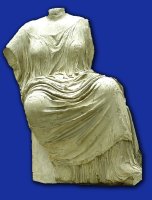The Mentor, went down off the coast of Kythera with most of the Parthenon Marbles on board, which were then hauled up by sponge-divers under the direction of Elgin's secretary William Hamilton.
http://krg.org.au/mentor/

Hugh Grant as William Hamilton in the film “Lord Elgin and Some Stones of No Value” courtesy of Milesian Film Productions Ltd.

Metal writing-holder and ink well found in the wreck of the Mentor, which sank off the coast of Kythira.
Between 6 - 15 July 2011 a team of the Department of Underwater Antiquities, under the direction of archaeologist Dr. Kourkoumelis, carried out underwater, archaeological excavations on the shipwreck “Mentor”, which sank in the southeast near Kythira Avlemona. This research has been funded and assisted the Australian Institute «Kytherian Research Group».
The ship, which carried the sculptures of the Parthenon was bound for England via Malta but sank at the entrance of the port of Avlemona southwest Kythera, in September 1802.
Captain Cousteau (1975), the Institute of Underwater Archaeology (1980) and the Department of Underwater Antiquities (2009) – all investigated the shipwreck but none were able to find or identified fragments of the marbles or sculptures.
Last year’s survey focused on area of the stern, where in 2009, various objects were identified including the ballast stones of the ship, several findings, such as fossil fish slate, which has since been presumed to be derived from the load. A portion of the shell of the ship was also cleared, which had already been identified by the survey of 1980, and found preserved in fairly good condition.
From the area surveyed, several objects were recovered from those that the 10 male crew would have used, including different types of cookware, glass, ceramic and porcelain, bottles, decorative items, which were apparently at the officers’ accommodation, coins of the period, two weapons like pistols, the decoration of a butt shot, bullets of different calibers three, stone lighters for arms, a small cannon shell, and navigation equipment, a small compass hand with gold chain and a compass on board.
The most significant were two ancient silver coins and a bronze coin, discovered between the ballast stones.
The results of this research are particularly interesting and encouraging, because this ship was intrinsically linked with the Parthenon sculptures removed by Lord Elgin’s team in Athens, and the objects recovered from the wreck are indicators of the welfare of seafarers merchant ships in a turbulent historical period of the Eastern Mediterranean.
The research continues and on the 26th of November in Athens a talk was given by Dr. Dimitrios Kourkoumelis, Archaeologist to the Ephorate of underwater Antiquities, entitled "The wreck of the Mentor in Kythira”. Dr Kourkoumelis showed the image of the metal writing-holder and ink well found in the wreck of the Mentor and that of Hugh Grant playing the role of William Hamilton (Lord Elgin’s secretary) in the film “Lord Elgin and Some Stones of No Value”. The project was undertaken by the Ephorate of Underwater of Antiquities in Greece, with assistance from the Kytherian Research Group (KRG) from Australia.
Major supporters were the Nicholas Anthony Aroney Trust and Kytherian Association of Australia. The project couldn’t have taken place without financial support from both these organisations.




 Demetrios Pantermalis, director of
Demetrios Pantermalis, director of 


